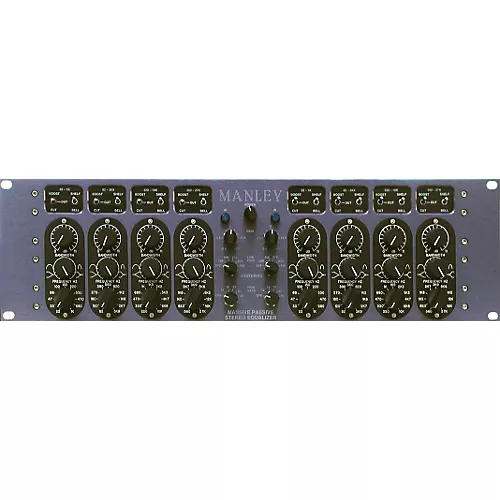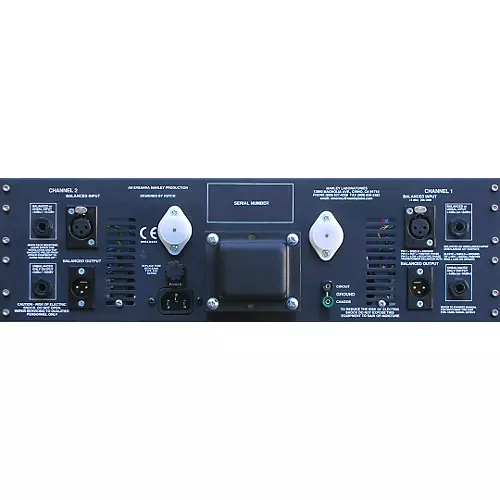Home
/
Manley Massive Passive Stereo EQ - Mastering Version
Manley Massive Passive Stereo EQ - Mastering Version
Quantity
-
DetailThe mastering version of the Manley Massive Passive Stereo EQ provides precisely repeatable settings. Manley came up with a clever way to pull it off without breaking your bank account: mechanically detented knobs for the Gain and Bandwidth controls to ensure repeatability-which is what everyone wanted, but without the incredible cost and space problems that tons of Grayhill switches would have caused. Some notes pertinent to the Manley Mastering Stereo EQ: The Manley Massive Passive is a passive design and not a "true parametric". A true parametric implies non-interacting controls. In the Massive Passive, the "GAIN" and "BANDWIDTH" controls DO interact (on purpose). It is not possible to create a "GAIN" switch that is set up for "consistent" 1/2 dB steps. When you change the "BANDWIDTH" the step size must and will change. On the regular version, you get a full 20dB boost or cut only when: the bandwidth is fully clockwise (narrow) in bell mode or fully counter-clockwise in shelf mode. Here on the Mastering Version, this maximum boost or cut is 11dB. Conversely at the widest bell, the maximum boost or cut is 6dB and the narrowest shelf maxes out at 12dB. A similar situation is also true for the bandwidth detents. So in this new Mastering Version, do not expect a certain dB change-per-step as it will vary according to where the bandwidth is set. But whatever the step sizes are, they will be a repeatable 16 steps. The FREQUENCY select is already detented and always has been a Grayhill switch. It also interacts in shelf mode.On a similar note, the Manley Massive Passive is a "parallel design" and not the conventional "series design". This means the bands interact with each other too. It is possible, to set a band to boost 20 dB but if another band is boosting near or at that frequency, very little will happen. On a conventional EQ the two bands "add" and you would be boosting 40 dB into clipping. Because the bands interact, predictable step sizes are unrealistic, however, with the Mastering Version, you will be able to repeat settings (if you log them of course). The price paid for interacting bands, is a better sounding EQ and bizarre looking settings (on purpose).Unlike virtually every other EQ, the Massive Passive Equalizer allows much more EQ without sounding "processed". Where 5- or 6dB is about all one could attempt with other EQs in mastering, the Massivo amazes engineers with how much EQ they can do and get more natural results at the same time. Manley could have squeezed 11-position Grayhill switches in the modules if they had wanted 1/2dB steps, but then the maximum range would have become only 5-1/2dB. The minimum range would then become about 1-1/2dB with approximately 0.2dB steps. This approach would have essentially thrown away most of the useful range the unit is capable of. Going with these special mechanically detented knobs, which use the same pots underneath that the normal Massivo uses, you get nearly all the range of the normal version, but with the added benefit of repeatability made possible by the detents.With mastering engineers in mind, Manley has custom-tailored the FILTERS in this Mastering Version, moving them lower and higher than the normal version. This was done specifically for mastering purposes. If you're looking for drastic effects (like telephone sounds) then get the normal version. These filters are specifically geared for mastering engineers.Additionally, the Master Gain Trim controls in the Manley Mastering EQ are true 11-position 1/2dB stepped Grayhill switches, set up for a range between -2.5 to +2.5 dBof master gain trim. This allows more confidence in left/right matching and calibration. The Filters - 5 frequencies Hi Pass and bypass, PLUS 5 frequencies Lo Pass with bypass.High Pass Filters = 12, 16, 23, 30, 39Hz, OFFLow Pass Filters = 15K, 20K, 27K, 40K, 52KHz, OFFThe filters are somewhat better tuned specifically for mastering. (They are flatter until the knee). As with the standard version the slopes are typically 18dB per octave, on these mastering filters except for the highest (52K) at 30 dB/octave.Parametric Frequencies (same as normal Massivo): LOW - 22, 33, 47, 68, 100, 150, 220, 330, 470, 680, 1KLM - 82, 120, 180, 270, 390, 560, 820, 1K2, 1K8, 2K7, 3K9HM - 220, 330, 470, 680, 1K, 1K5, 2K2, 3K3, 4K7, 6K8, 10KHI - 560, 820, 1K2, 1K8, 2K7, 3K9, 5K6, 8K2, 12K, 18K, 27K
-
Customer ReviewsNo comments

 Fender
Fender Gibson
Gibson Taylor
Taylor Martin
Martin lbanez
lbanez Epiphone
Epiphone PRS
PRS Schecter Guitar Research
Schecter Guitar Research Fender Stratocaster
Fender Stratocaster Fender Telecaster
Fender Telecaster Gibson Les Paul
Gibson Les Paul Gibson SG
Gibson SG lbanez RG
lbanez RG Taylor American Dream
Taylor American Dream Taylor GS Mini
Taylor GS Mini Martin GPC
Martin GPC lbanez
lbanez Fender
Fender Squier
Squier Ernie Ball Music Man
Ernie Ball Music Man Sterling by Music Man
Sterling by Music Man Rickenbacker
Rickenbacker Sire
Sire Schecter Guitar Research
Schecter Guitar Research Fender Precision Bass
Fender Precision Bass Fender Jazz Bass
Fender Jazz Bass Fender Mustang
Fender Mustang lbanez SR
lbanez SR Strandberg Boden
Strandberg Boden Yamaha TRBX
Yamaha TRBX Yamaha BB
Yamaha BB Schecter Stiletto
Schecter Stiletto Fender
Fender Marshall
Marshall Orange Amplifiers
Orange Amplifiers Markbass
Markbass Boss
Boss Blackstar
Blackstar Kemper
Kemper Vox
Vox Line 6
Line 6 Electro-Harmonix
Electro-Harmonix MXR
MXR Meris
Meris Dunlop
Dunlop EarthQuaker Devices
EarthQuaker Devices lbanez
lbanez TC Electronic
TC Electronic Alesis
Alesis Roland
Roland Zildjian
Zildjian DW
DW Simmons
Simmons Meinl
Meinl Remo
Remo TAMA
TAMA Pearl
Pearl Vic Firth
Vic Firth Sound Percussion Labs
Sound Percussion Labs Evans
Evans Sabian
Sabian Lp
Lp Yamaha
Yamaha Yamaha
Yamaha Roland
Roland Korg
Korg Williams
Williams Akai Professiona
Akai Professiona Casio
Casio Nord
Nord Moog
Moog Williams Legato
Williams Legato Yamaha Clavinova
Yamaha Clavinova Harbinger
Harbinger Bose
Bose JBL
JBL Electro-Voice
Electro-Voice Behringer
Behringer Yamaha
Yamaha Mackie
Mackie JBL EON
JBL EON Bose L1 Pro
Bose L1 Pro QSC K Series
QSC K Series Yamaha Mixers
Yamaha Mixers Harbinger VAR!
Harbinger VAR! Focusrite
Focusrite Universal Audio
Universal Audio Yamaha
Yamaha PreSonus
PreSonus Tascam
Tascam KRK
KRK Rode
Rode Focusrite Scarlett
Focusrite Scarlett Universal Audio Apollo
Universal Audio Apollo Shure
Shure Sennheiser
Sennheiser AKG
AKG Neumann
Neumann Rode
Rode Sterling Audio
Sterling Audio Audio-Technica
Audio-Technica Warm Audio
Warm Audio AKG 414
AKG 414 Musician Geal
Musician Geal Fender
Fender D'Addario
D'Addario Ernie Ball
Ernie Ball Elixir
Elixir Road Runner
Road Runner Gator
Gator Proline
Proline Remo
Remo Livewire
Livewire On-Stage
On-Stage Hercules
Hercules Mogami
Mogami Dunlop
Dunlop Perri's
Perri's Snark
Snark

